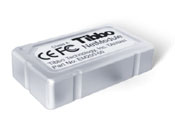EM200
 This is a legacy device. The following information is provided as it was documented originally, albeit with some corrections and changes for clarity and style.
This is a legacy device. The following information is provided as it was documented originally, albeit with some corrections and changes for clarity and style.

Introduction
The EM200 is a Tibbo BASIC/C-programmable embedded module that can serve as a networking coprocessor of your "connected" device. The firmware of the EM200, called Tibbo OS (TiOS), features a virtual machine that executes your application written in Tibbo BASIC/C. The EM200 has no predefined functionality whatsoever — programmability in Tibbo BASIC/C means that you can create your own unique EM200 applications!
Each hardware faculty of the EM200 is supported by a sophisticated programming object, which you interact with from the Tibbo BASIC/C application. Together, objects form a platform that defines the EM200's capabilities from the programming point of view.
Hardware Features
- Very compact dimensions (32.1 x 18.5 x 7.3 mm)
- One 100/10BaseT Ethernet port (standard Ethernet magnetics are NOT integrated into the module)
- One serial ports (CMOS-level):
- Baudrates of up to 115,200bps
- None/even/odd/mark/space parity modes
- 7/8 bits/character modes
- Full-duplex mode with optional flow control
- Half-duplex mode with automatic direction control
- Encoding and decoding of Wiegand and clock/data streams
- Nine general-purpose I/O lines
- 128KB flash memory for TiOS and application code
- 2KB EEPROM for data storage
- Four control lines for status LEDs:
- Two lines for green and red status LED control
- Two lines for Ethernet status LED control
- External reset input line
- Device firmware can be upgraded through the serial port or Ethernet.
- Tibbo BASIC/C application can be uploaded and debugged through the Ethernet.
Programming Features
The EM200 runs Tibbo OS (TiOS). The following is a list of the features supported by its programming platform:
- Objects:
- button — monitors the MD (setup) line
- io — handles I/O lines, ports, and interrupts
- net — controls the Ethernet port
- pat — "plays" patterns on up to five LED pairs
- romfile — facilitates access to resource files (fixed data)
- ser — in charge of serial ports (UART, Wiegand, and clock/data modes)
- sock — socket communications (up to 16 UDP, TCP, and HTTP sessions)
- stor — provides access to the EEPROM
- sys — in charge of general device functionality
- The following data types and related functions are supported:
- Byte and char (occupy 1 byte)
- Integer (word) and short (occupy 2 bytes)
- String, can be up to 255 characters long
- The following function groups are supported:
- Conversion to and from strings: asc, chr, val, str, left, mid, right, len, instr, etc. (16 functions in total)
